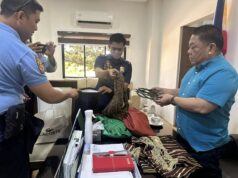HAGONOY, Bulacan—Just two days after floods subsided in the most part of Bulacan, three towns in the province are bracing for back floods from the Candaba Swamp in Pampanga.
The Provincial Disaster Risk Reduction Management Office (PDRRMO) said that they have evacuated closed to 100 families from Calumpit and Pulilan towns.
The two towns are located on the boundary of Bulacan and Pampanga, and some of their villages are lying on the southern bank of the Pampanga River which swelled due to heavy rains brought by tropical storm Falcon.
In the case of this coastal town, roving vehicles warned residents early yesterday morning to brace for back floods. This town lies at the end of the 50-kilometer Angat river that drains to Manila Bay and like the nearby Calumpit and Pulilan towns, it serves as a natural catch basin for back floods that comes from eastern Central Luzon.
Based on experience and studies by experts, back floods normally hit the three towns of Bulacan three to four days after a weeklong heavy downpour on eastern Central Luzon plains.
This is due to the fact that rain that fell on Nueva Ecija, Tarlac, Pampanga and eastern Bulacan usually found its way to the Pampanga river and settles briefly on Candaba Swamp before draining to the downs stream of Pampanga river.
However, the Pampanga river is connected to Angat river by a short river branch in Calumpit town. Raul Agustin, special operations officer of the PDRRMO, said that some 100 families were evacuated from Barangays Meysulao and San Miguel in Calumpit town; and from Barangays Inaon and Paltao in Pulilan town on Monday afternoon.
He said that Barangays Lumbac, Penabatan, and Sto. Cristo in Pulilan town were also threatened by back bloods. For her part, Liz Mungcal, head of the PDRRMO, said that back floods is one of the four types of flood that they have to deal with in Bulacan.
The others are flash floods like the one that hit Sta. Maria and Bocaue towns during the onslaught of Ondoy in 2009; the regular floods that usually come right after heavy down pour due to clogged waterways; and the flood caused by high tide.
Mungcal said that these floods sometimes develop into a “combo type” or combination of any of the two or three.
For this reason, the municipal government of this town sent out roving vehicles with sound systems and warned residents of possible back floods in the next 24-hours.
Based on experience, back floods brought by Ondoy inundated this town more than a week after flash floods hit the towns of Sta. Maria, Bocaue, Marilao and the City of Meycauayan in 2009.
Meanwhile, residents of this coastal town said they are now used to the floods brought by high tide and back floods.
Many usually lift furniture and appliances in their homes days before the flood, while those who owns motor vehicles normally secure such by parking their cars on higher grounds.




